The Best Dumbbell Exercises For All Levels Of Gym-Goer
Beginner, intermediate and advanced dumbbell exercises to build muscle and strength all over your body

Everyone knows at least one dumbbell exercise – curls – but there’s so much more you can do with them, whether you’ve got a pair of adjustable dumbbells at home or a well-stocked rack of dumbbells in a gym. You can target any body part and build muscle, or string a series of movements into a pulse-raising workout to burn calories and burn fat, or work on your muscular endurance with high-rep sets.
Here we aim to introduce you to the essential movements everyone should master, with recommendations from PT and Multipower ambassador Ant Nyman as well as the Coach team’s tried-and-tested favourites.
If you prefer to practise them at home, our round-up of the best dumbbells can help you find a pair to suit your budget and needs. We also have plenty of dumbbell workouts for you to try which feature the exercises on this page. But before we dive into our selection, here are a few reasons why dumbbell exercises may be the best kind of weighted exercises.
The Benefits Of Using Dumbbells
First up, dumbbells are the most accessible type of free weights and tend to be the first piece of equipment people buy to train at home, as well as a reassuringly straightforward place to start in the weights room. They are also easier to get the hang of than kettlebells – the snatch, for instance, adds another layer of complexity when done with kettlebells – and unlike barbells your wrists aren’t fixed in a sometimes unnatural position.
While barbells let you lift more weight, even if you usually gravitate towards the barbell to tackle big lifts like the back squat, deadlift and bench press, there’s one key reason to make sure you also find time for dumbbell exercises.
“When using a barbell, your weaker side can get an easy ride,” says Nyman. “You can move the weight predominantly using your stronger side, meaning one side will always lag behind. Using dumbbells nullifies this problem because each side has to work individually, meaning you’ll develop strength and size evenly on both sides.”
There are extra benefits to dumbbell exercises beyond working the targeted muscles. “The unstable nature of holding dumbbells also ensures that your stabiliser muscles have to work hard to keep you steady while you perform the movement. Without realising it you’ll be strengthening your core and other stabiliser muscles, which can help prevent injury.”
Sign up for workout ideas, training advice, reviews of the latest gear and more.
Beginner Dumbbell Exercises
Lateral raise
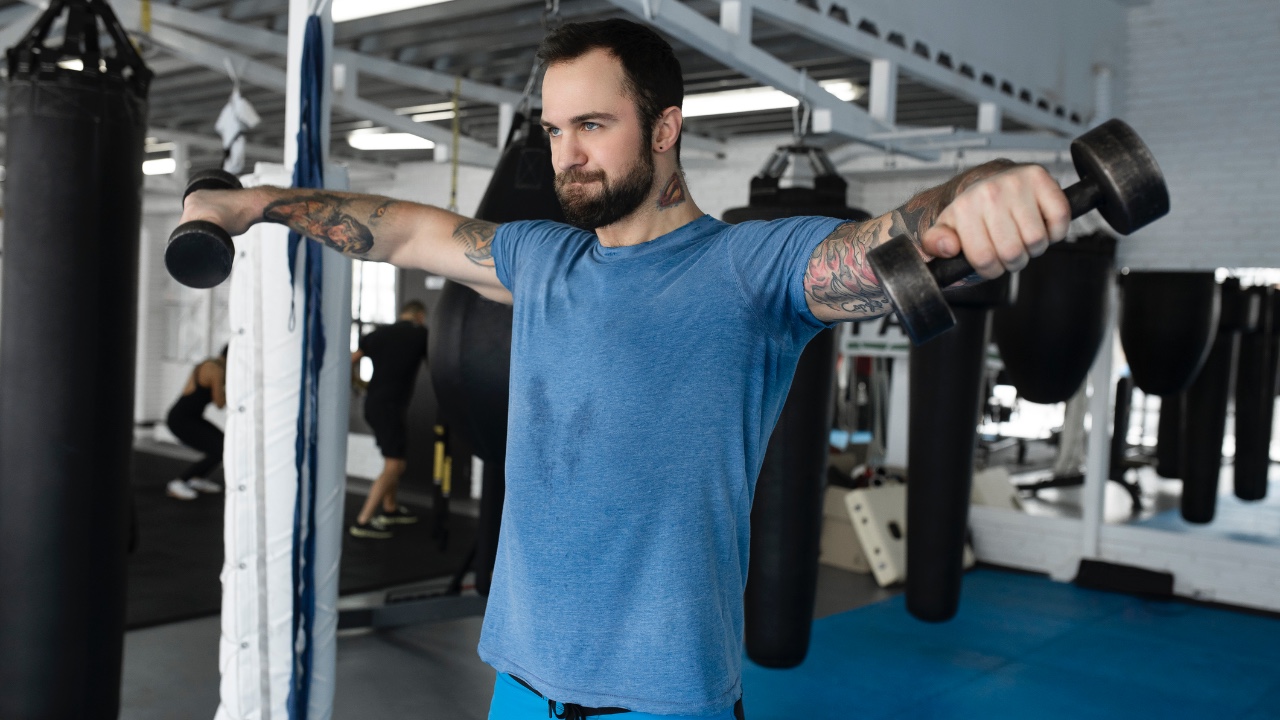
Why “Lateral raises target the medial (outer) head of the deltoid muscle,” says Nyman. “You don’t need an awful lot of core strength to perform the movement, which is why it’s good for beginners.
How Stand holding a dumbbell in each hand next to your outer thighs. Keep your back straight and slowly lift the weights out to the sides until your arms are parallel with the floor. Your elbows should be slightly bent. Slowly lower the dumbbells back to the starting position.
Form tip “Imagine you are holding a bucket in each hand. As you raise your arms out to the side, tip the buckets as if to pour out the contents so that your thumbs point to the floor. This will ensure you hit the medial head as opposed to over-developing the front delt.”
Overhead press
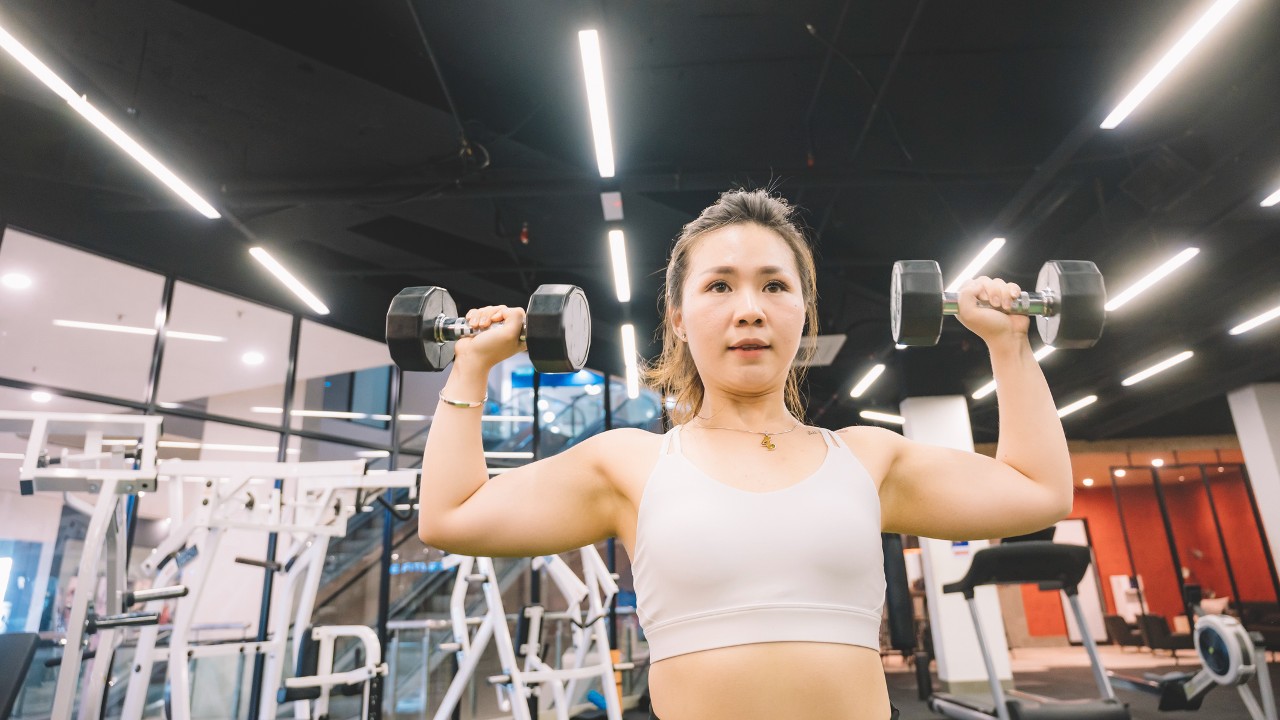
How “While lateral raises are good for working the delts, performing heavy overhead (or shoulder) presses is a great way to add serious strength,” says Nyman. “Make sure you don’t arch your back too much. If you do you’ll probably end up using your upper chest instead of your shoulders.”
Why You can do this either seated or standing. Hold a pair of dumbbells by your shoulders with your elbows out to the sides and bent at 90°. Extend through your elbows and press the weights overhead, then slowly bring them back to the starting position.
Biceps curl
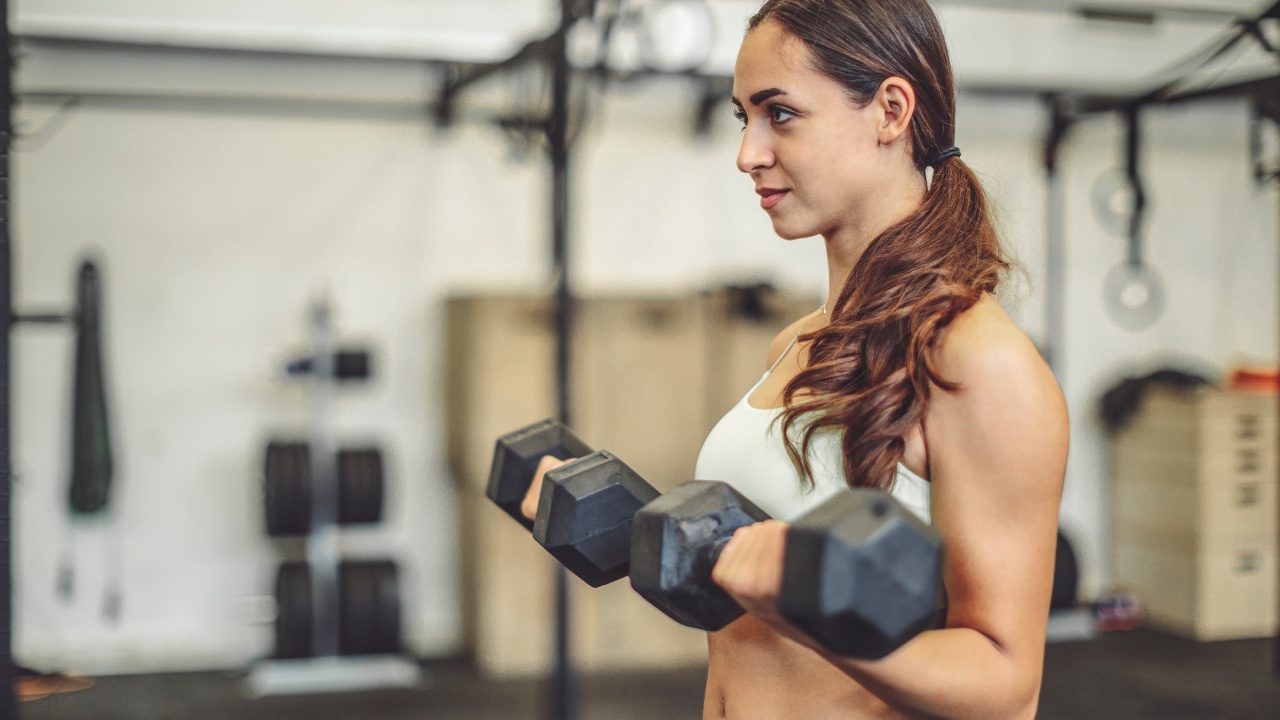
Why “If you’re a beginner you may be wary of picking up heavy weights. With biceps curls you won’t need to worry about that because it’s not about going heavy, it’s about the feel of the muscle lengthening and shortening. You can change grip to target different heads of the muscle but for a beginner I’d recommend using a supinated grip – palms facing up.”
How Hold a pair of dumbbells in front of your thighs with your palms facing out. Slowly curl the dumbbells up to your chest and then back down again.
Form tip “Keep your elbows pinned to your sides,” says Nyman. “The minute your elbow comes up you are shifting the emphasis away from your biceps and onto your shoulders.
Variations Once you’ve mastered the basic dumbbell curl, graduate to the hammer curl with palms facing to target the brachialis muscle (on the outside of the arm next to the biceps). The Zottman curl is also a worthy variation to add to your repertoire to add a side of forearms work to the biceps builder.
Triceps kick-back
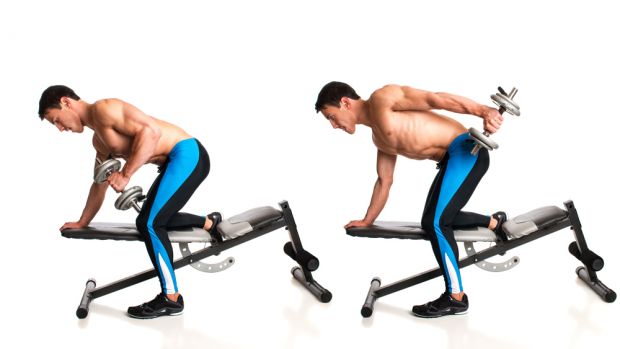
Why Pair this dumbbell exercise with the biceps curl to ensure you’re working both of the major muscle groups in your upper arm. Like the biceps curl, the triceps kick-back is an isolation move, in that it targets solely the triceps.
How Set up a bench so you can place one knee, shin and foot on it, and then bend over until your torso is parallel to the floor, holding the bench with one hand. In the other hand, hold a dumbbell and place your upper arm against your body with your elbow bent at 90°. Straighten your arm, moving the dumbbell backwards until your forearm is parallel to the ground, making sure to keep your upper arm still so you’re only using your triceps for the lift. Slowly lower the weight back to the start.
Lunge
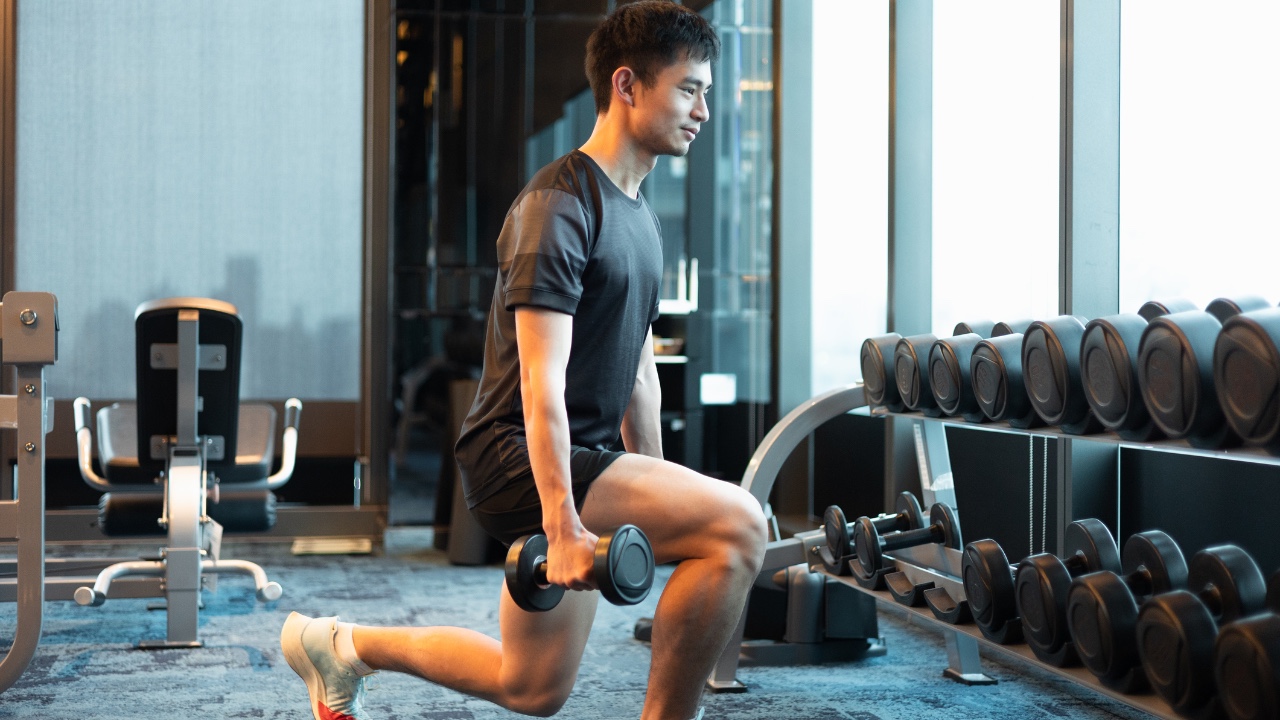
Why “Working your legs is essential for many reasons, including building strength, muscle and burning loads of calories,” says Nyman. “But if you’re a beginner the thought of getting under a heavy barbell for a set of squats may seem intimidating. So instead grab a pair of dumbbells and get lunging. It’s a great way to add resistance to your legs and glute work, without the fear of being left in a heap under the squat rack.”
How Holding dumbbells by your sides, take a big step forwards and lower your body until both knees are bent at 90°. Then push up through the front leg and return to the starting position.
Floor press
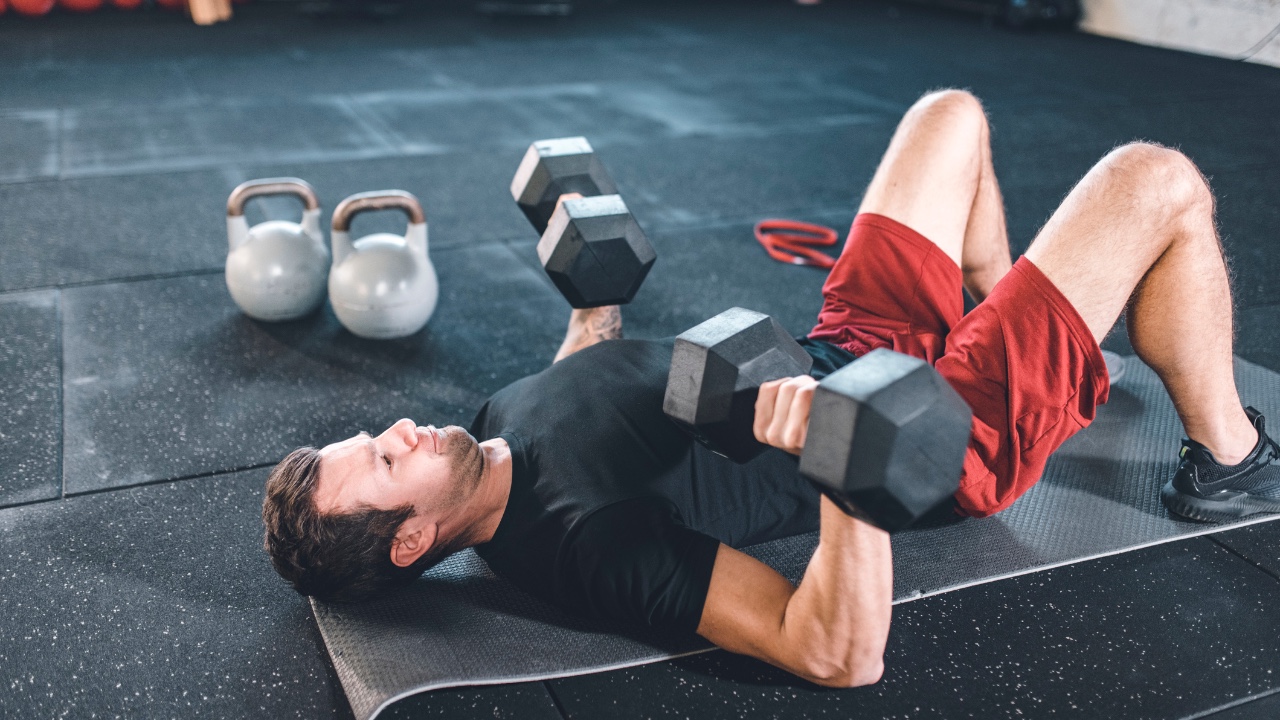
Why Presses are among the fundamental movements everyone should master, and starting with dumbbells is a great option for beginners – and not just because the minimum weight you can press with a barbell is normally 20kg. Using dumbbells will work more muscles around the shoulders and chest than using a barbell because those muscles are forced to keep the weights stable, and it’s well worth developing those muscles before moving on to heavier barbells. Switching to a hammer press, with your palms facing, is a good beginner’s option because it places less strain on your shoulders, as does the floor press owing to the reduced range of motion.
How Lie with your feet and back flat on the floor, knees bent, holding dumbbells either side of your chest. Press the weights straight above you, then lower slowly until the backs of your upper arms touch the floor. This makes the move harder, since it removes the tension from your muscles, so it takes more to initiate the next rep.
One-arm dumbbell row
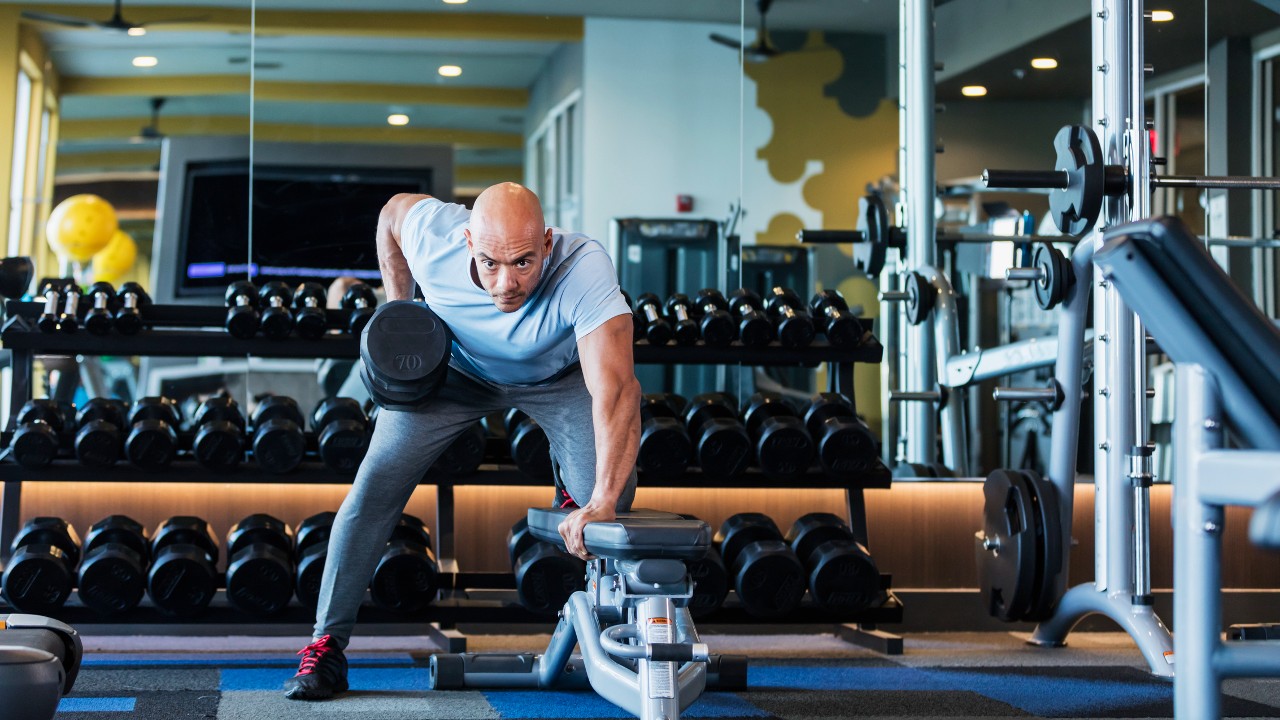
Why Opting for this one-arm row to work your back over the classic bent-over row (below) makes it easier to focus on the side you’re working and also to ensure your body is in the right position, because you are supporting the upper body with your other arm.
How Place one knee on a bench and lean over to place your hand on the bench so your upper body is parallel to the ground. Reach down with your other arm to grab the dumbbell, then row it up to your chest, focusing on lifting it with your back and shoulder muscles. Pause at the top of the move, then lower the weight slowly.
Calf raise
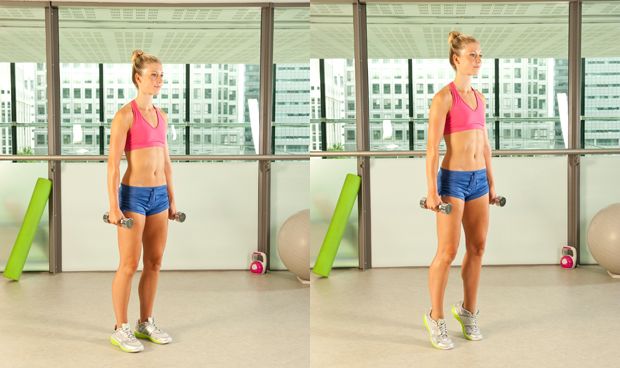
Why Your calf muscles are among the trickiest to target during a workout. Your best option is to incorporate some kind of calf raise into your routine. This is an especially important move for runners, because the calf muscles have to bear a lot of the impact, so ensuring they’re strong enough to handle your training should be a key concern in your supportive workouts.
How The calf raise is a very simple move. Stand holding heavy dumbbells, then push through your toes to raise your heels off the floor. Then lower your heels back down. You can vary the part of the calf you work by bending your knees during a raise, or doing them off a raised platform like a step or kerb, so your heels can sink below toe level.
Dumbbell woodchop
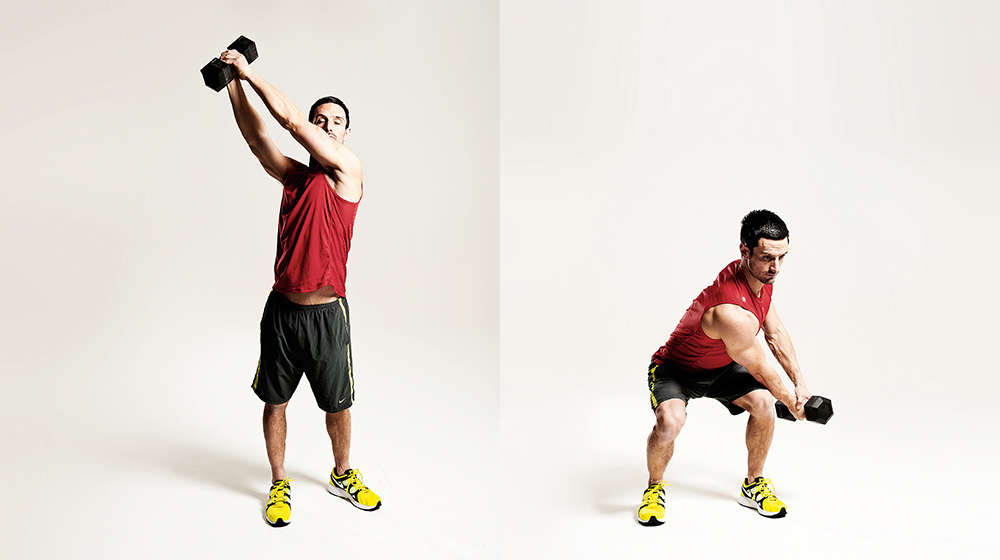
Why This functional dumbbell exercise is terrific for core strength, with the rotational movement many of us lack in our gym routines – which often consist entirely of forward and back, up and down, and side-to-side moves. If you’re a golfer then make sure you start woodchopping ASAP, because the increase in rotational power you’ll gain will add serious yardage to your drives.
How Stand holding a dumbbell in both hands, then lower into a squat and move moving the dumbbell to the right, until your thighs are parallel to the floor and the dumbbell is outside your right thigh. Drive up to standing and twist your torso to bring the dumbbell across and up until it’s above your left shoulder, keeping your arms extended throughout. Twist to come slowly back down to the starting position. Perform all your reps in one direction, then switch sides.
Farmer’s walk
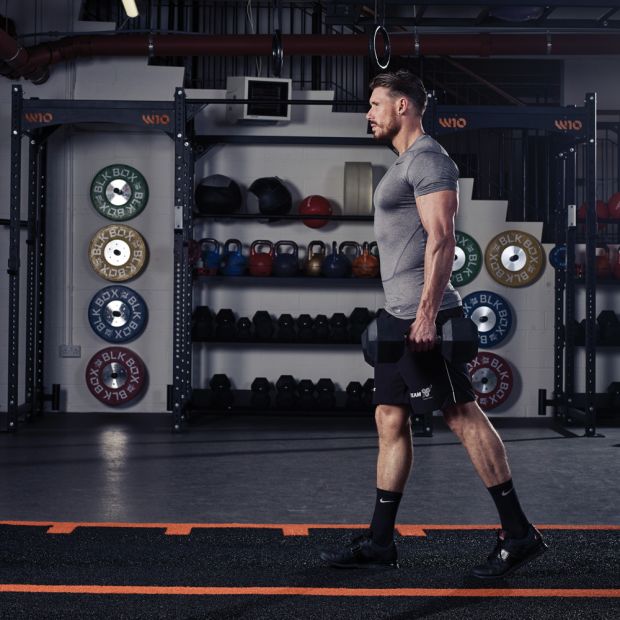
Why You’ll feel the benefits of this functional dumbbell exercise the next time you do a big shop. The farmer’s walk is also great for your grip strength and will help to improve your posture, and it’s a move with a very low injury risk since the form is easy to master.
How Hold a heavy dumbbell in each hand and walk for a set distance, like 10m, or duration, taking short steps and keeping your core braced and torso upright – don’t let the weights drag you down.
Intermediate Dumbbell Exercises
Chest flye
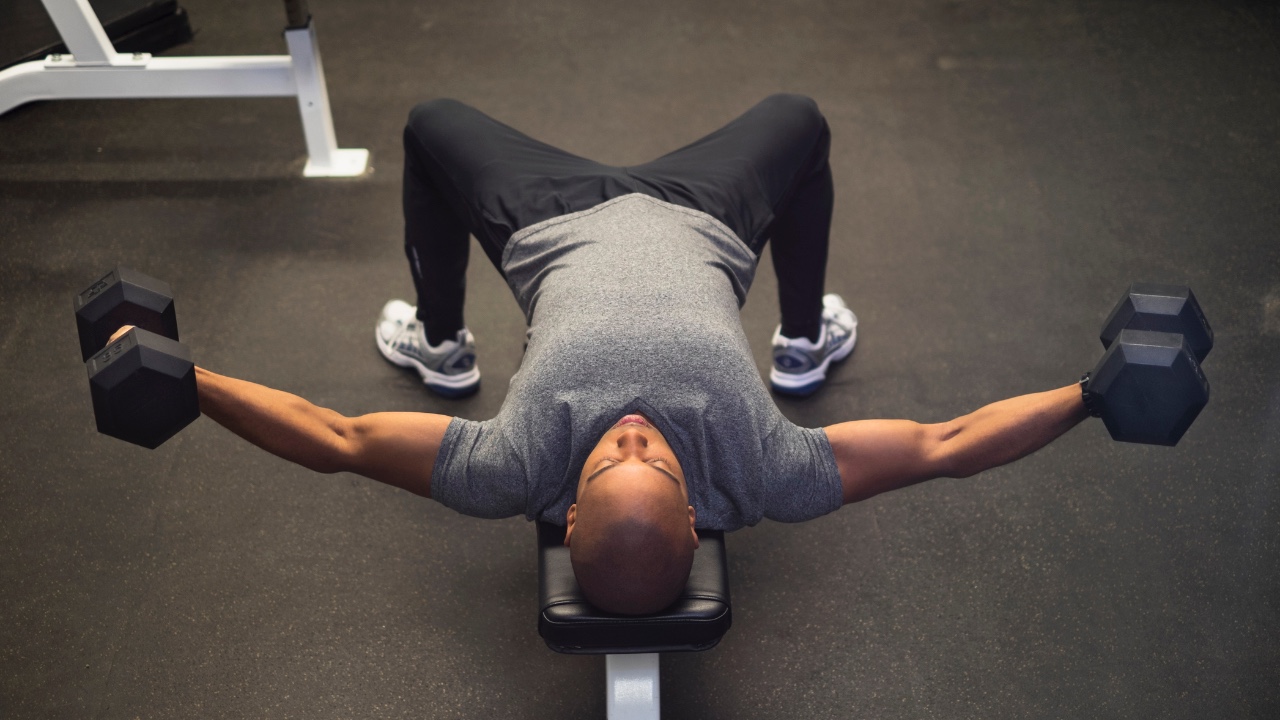
Why “Doing chest flyes is a great way to isolate the chest,” says Nyman. “Most pressing chest movements will enlist the help of the shoulders and triceps, but flyes keep the focus purely on the chest.
How Lie on your back on a flat bench with your feet on the floor. Hold the dumbbells above your chest with your arms almost straight, palms facing each other. Slowly lower them out to the sides, then bring them back up above your chest. Your arms should have a slight bend in the elbows throughout.
Form tip “Exaggerate the arch in your lower back slightly. This will help keep the tension on your chest as opposed to your shoulders.”
Bent-over row
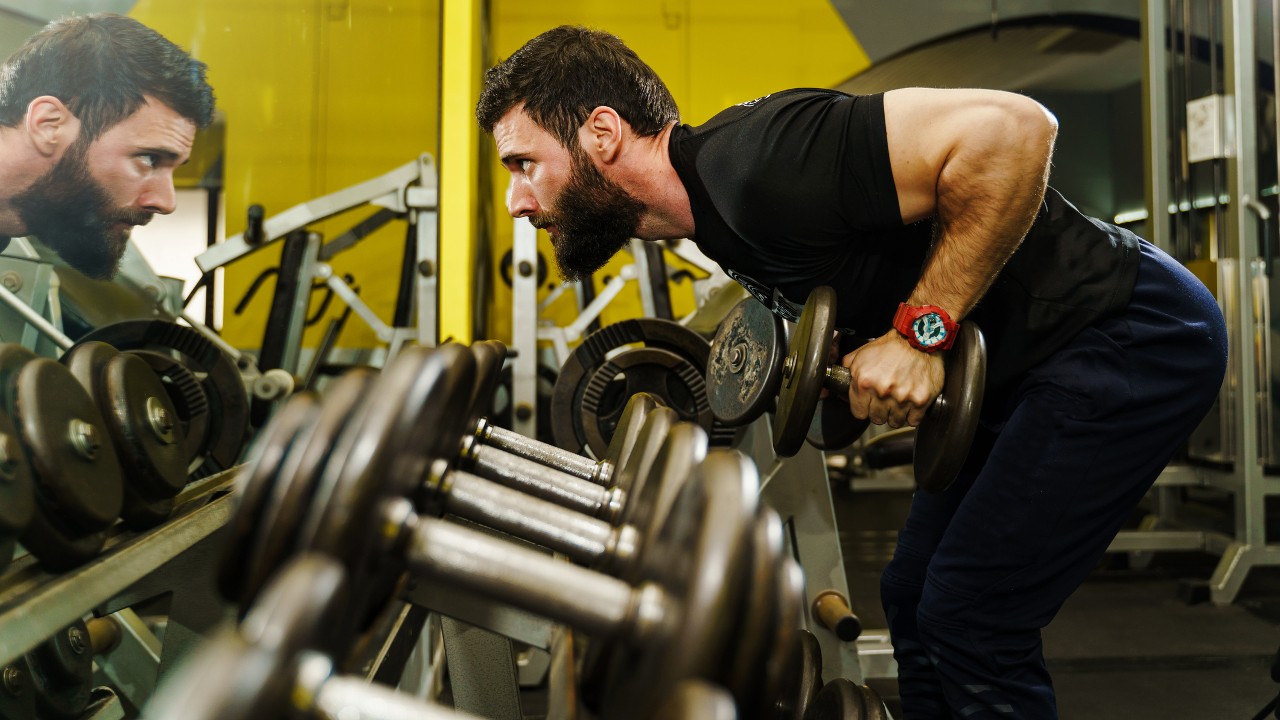
Why “Using dumbbells to perform bent-over rows is a great way to ensure you develop both sides of your upper back evenly,” says Nyman.
How Stand with your feet shoulder-width apart. Bend your knees and lean over from your waist, keeping your neck lined up with your spine. Let the dumbbells hang with straight arms, then slowly bring them up to your chest by squeezing your shoulders together.
Form tip “Think of Donald Duck – stick your bum out and ensure you maintain the natural curve in your lumbar spine (lower back).”
Front squat
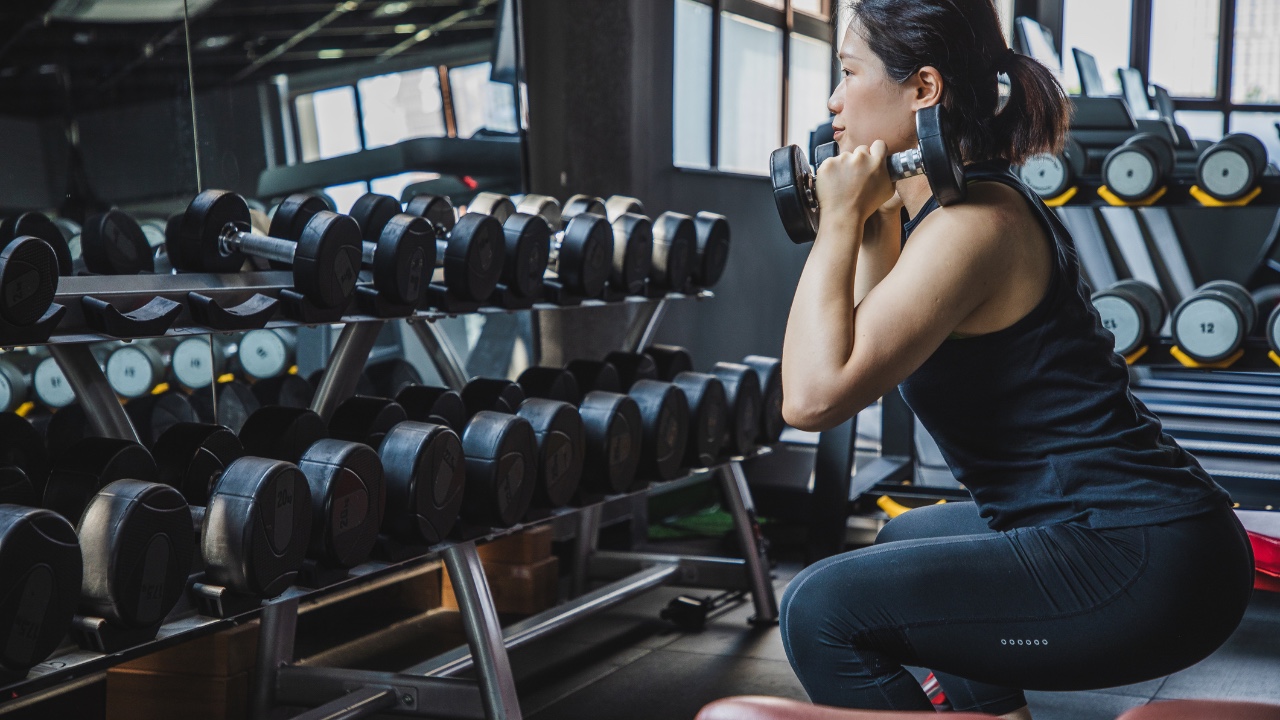
Why “It’s not as daunting as getting under a loaded barbell, and performing squats while holding dumbbells by your shoulders will challenge your core in a different way to the barbell version,” says Nyman. “Because the weight is slightly in front of you, you’ll place more emphasis on your quads, too.”
How Hold a pair of dumbbells up by your shoulders with your elbows by your sides and palms facing each other. Lower into a squat until your thighs are parallel with the ground, then drive back up to the starting position.
Front raise

Why The first thing to know about this dumbbell exercise is that it works the front part of your shoulders. The second thing to know is that you need to use light dumbbells. You don’t need much weight at all to work this area, and going too heavy risks a shoulder injury.
How Hold dumbbells in front of your thighs in an overhand grip, so your palms face your body. Keeping your arms extended and your back straight, lift the weight in front of you to shoulder height, then lower it slowly. You can lift two dumbbells simultaneously or work one arm at a time.
Arnold Press
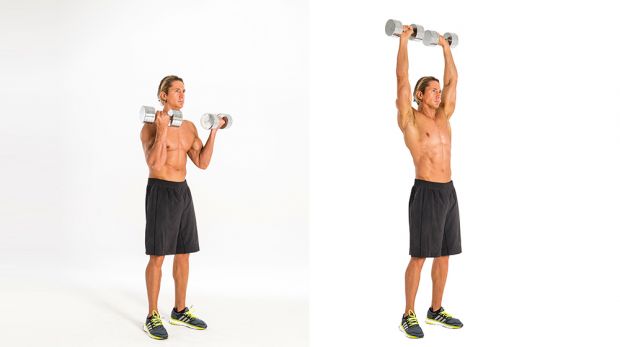
Why Everyone starts to think they’re the Terminator after a few good lifting sessions, so here’s a move the Terminator himself made famous. The Arnold Press works all three sections of your deltoids – or machine-gun stabilisers, as we’re sure the the Austrian Oak refers to them – and keeps your muscles under tension for longer than a standard overhead press.
How Stand holding dumbbells in front of your chest using an underhand grip, as though you’re midway through a biceps curl. Open your arms out to the sides while rotating your wrists 180° then, without pausing, press the dumbbells above your head.
Plank drag

Why The plank drag is a simple and effective way to increase the difficulty of the classic plank by adding movement to test your balance and force your core muscles to resist your torso rotating as you reach and pull.
How Set up in a high plank position, supporting your body on your hands and toes while forming a straight line from your neck to your heels. Position the dumbbell on the floor, level with your chest on your left side. While maintaining your plank position, reach across and under with your right hand to grab the dumbbell and drag it under your body over to your right side. Then put your right hand back down and drag the weight the other way with your left hand. Make sure to engage your abs when dragging the weight so it’s not just your arms doing the work.
Advanced Dumbbell Exercises
Split squat

Why “These are tough at the best of times but performing them with a dumbbell in each hand will take it to a whole new level,” says Nyman. “You’ll feel every muscle in your legs and glutes working hard just to stabilise yourself.
How Get into a staggered stance, holding dumbbells by your sides. Using your legs, slowly lower as far as feels comfortable, then push back up to the starting position. For a tougher variation of the split squat, put your back foot on a bench.
Form tip “Keep your chest up throughout the movement. Push up through your heels as opposed to your toes to target the quads and glutes instead of your calves.”
Chest pull-over

Why “This is a great way to finish off a chest workout and target the upper and inner sections of your chest,” says Nyman.
How Lie on your back on a bench, holding a dumbbell in both hands above your head. Keep your arms straight but not locked. Slowly lower the dumbbell behind your head until you feel a stretch in your chest. Return to the start position and squeeze your chest hard at the point of contraction.
Dumbbell snatch
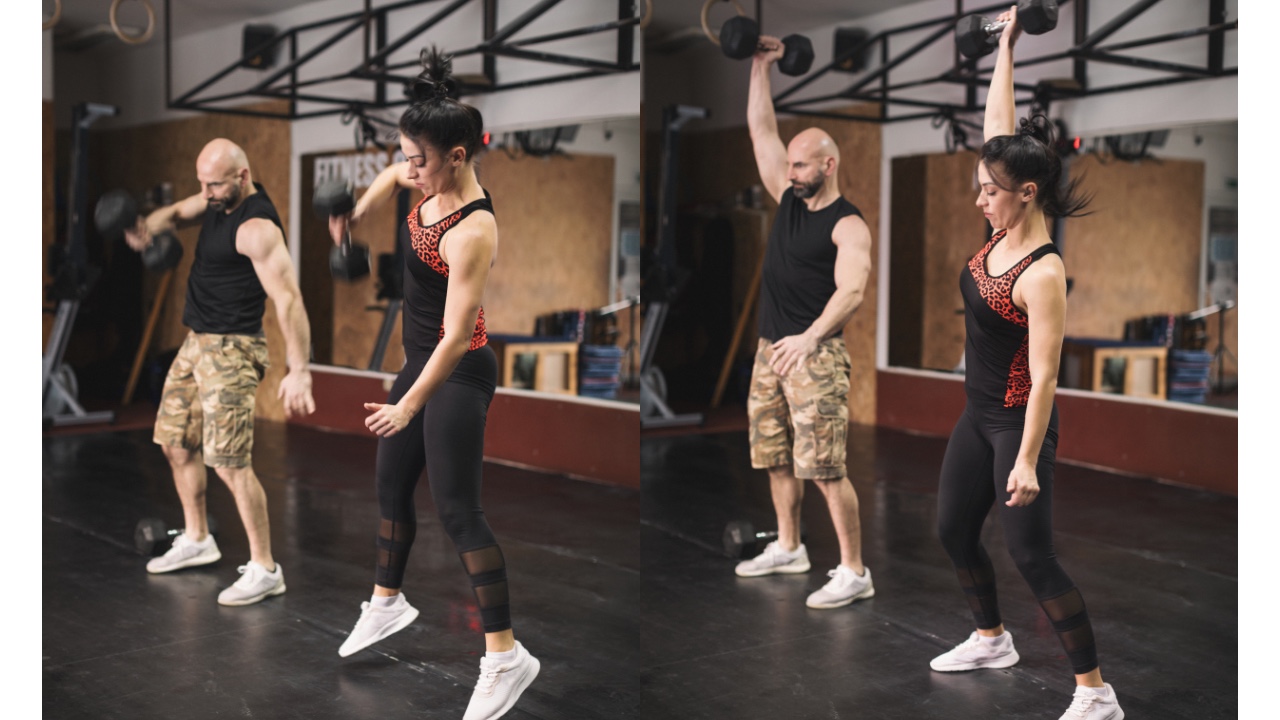
Why The snatch is a full-body exercise which also requires you to execute the triple extension at the ankles, knees and hips – the type of explosive movement that will give you the edge when playing sport.
How Stand holding a dumbbell in one hand. Lower into a squat and touch the dumbbell to the floor between your feet. Then drive your hips forwards to stand up and lift the weight explosively. Once it reaches chest height, flip your wrist under the dumbbell and then push it above your head until your arm is fully extended. Do it right and the final press will be a fluid extension of the move using the momentum created by your legs and hips. If you have to press the weight overhead using mostly your arm, then get your technique checked and/or use a lighter weight.
Single-leg Romanian deadlift
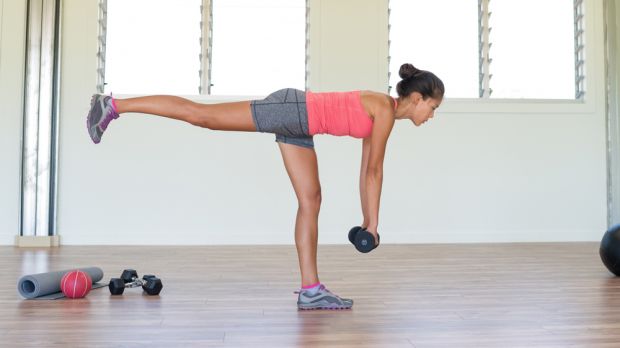
Why This fantastic functional move trains each leg in turn to mimic the movement of running, and it also helps to build a strong posterior chain. It’s also an incredibly frustrating move at times, because it tests your balance as well as your strength.
How Stand holding dumbbells, using a lot less weight than you would for a two-footed deadlift. Lift one foot off the ground and hinge forwards at the hips, raising your foot behind you for counterbalance, to lower the weights towards the floor. Stop when you feel a stretch in your standing leg’s hamstring and snap your hips forwards to come back up to standing.
Renegade row

Why The most demanding dumbbell row asks you to hold a plank while pulling the weights up to your chest – a stern test, especially if you don’t rush your reps.
How Use dumbbells with hexagonal weights to provide a firm base, otherwise you risk turning your wrists. Get into the top press-up position, holding the handles of the dumbbells with your hands under your shoulders and spreading your feet wide to ensure a stable base. Brace your core and keep your torso as still as possible throughout the move. Lift one dumbbell towards your chest, keeping your arm close to your body. Lower under control, then repeat on the other side. Continue, alternating sides.
Thruster
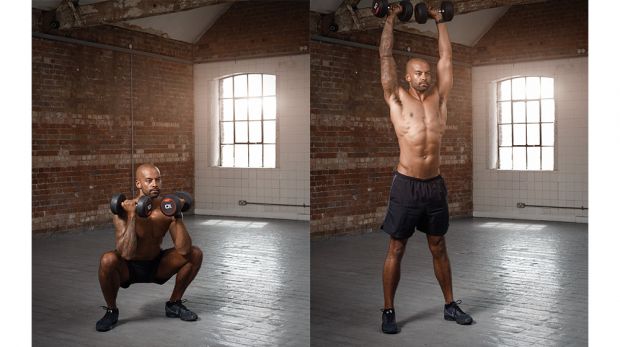
Why A dumbbell thruster is a fiery little move – literally, because you’ll feel the burn in a lot of different muscles. It’s also a great way to build up to the barbell thruster and to iron out any strength imbalances.
How Stand holding dumbbells at shoulder height with your palms facing. Your feet should be shoulder-width apart with your toes pointing slightly outwards. Squat down slowly, then explode up, thrusting the dumbbells above your head so that your arms are extended. Work on making the action from the bottom of the squat one fluid movement – it shouldn’t be a squat followed by an overhead press.
Dumbbell reverse flye
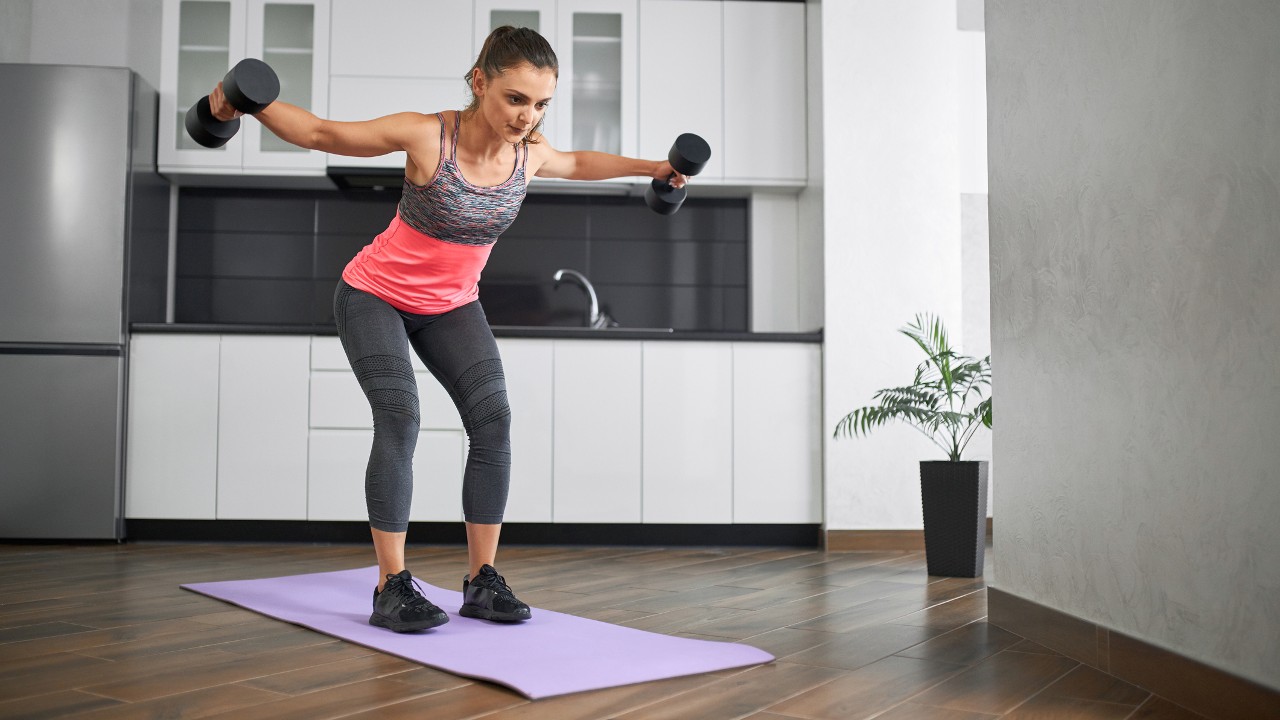
This challenging shoulder exercise should be done with light weights to make sure you don’t pull your body out of position during the move. Stand holding a weight in each hand with your palms facing. Hinge forwards at your hips and let the weights hang down beneath you. Keeping a slight bend in your elbows, lift the weights out to the sides, then bring them back down slowly. The reverse flye is a great move for working the side and rear parts of your shoulders and will help you build a broader upper back.
Dumbbell FAQs
Can you build muscle with dumbbells?
You sure can, although it’s less to do with the type of weight, and more to do with getting the heaviness, reps and sets right. Our guide to hypertrophy training will help, but broadly speaking, to build muscle perform a weighted exercise between 10-15 times – 12 is typical – using a weight which makes the final rep a challenge. Rest, then repeat that sequence for a total of two or three times.
How do you lose belly fat with dumbbells?
The short answer: follow this workout plan for losing belly fat. It uses dumbbell circuits to both raise your heart rate and burn calories – and you’ll also build muscle mass, which will raise your body’s natural resting metabolic rate.

Nick Harris-Fry is a journalist who has been covering health and fitness since 2015. Nick is an avid runner, covering 70-110km a week, which gives him ample opportunity to test a wide range of running shoes and running gear. He is also the chief tester for fitness trackers and running watches, treadmills and exercise bikes, and workout headphones.
- Jonathan ShannonFormer editor
- Jake StonesContributor
